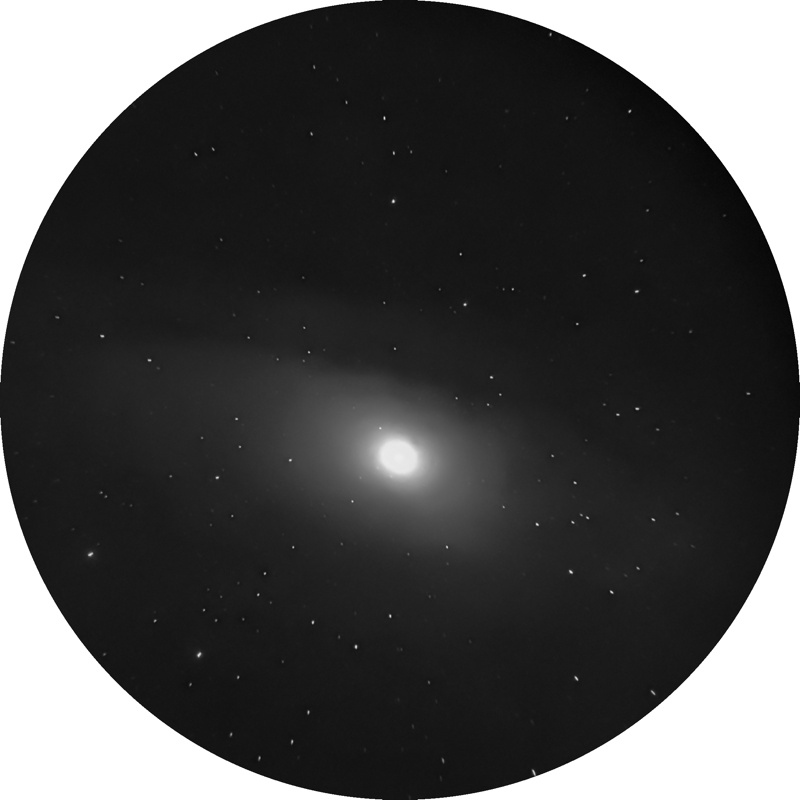Barnard 143 Dark Nebula,
iPhone 13 Pro Max Astrophotography
Posted: 31 October 2021
|
Open: Saturday, 30 October 2021, 1720 MST Temperature: 74°F |
Session: 1685 Conditions: Clear |
Equipment:
12" f/8 LX600 w/StarLock
2" 24mm UWA eyepiece
2" 50mm eyepiece
2" 30mm eyepiece
2" UHC filter
Camera:
D850 DSLR
iPhone 13 Pro Max
When I arrived inside the observatory I saw that my visitor from the previous session was still there.

1728 MST: LX600 ON, StarLock OFF, High Precision OFF.
Before the Sun set I viewed Venus, Saturn, and then Jupiter and the Great Red Spot, 102X.
1733 MST: sunset.
I then relaxed on the observatory patio bench while waiting for twilight to end.
1813 MST: Dome OFF.
Prepared the D850 DSLR for imaging. Then took a quick look at Jupiter, 102X, before returning to the bench.
1840 MST: back inside the observatory. Observed Jupiter, 102X.
Mounted the D850 DSLR at prime focus + focal reducer + UHC filter, focused on the star Altair, locked the 12" primary mirror.
1852 MST: Wi-Fi ON.
Used SkySafari 6 Pro on the iPhone to GOTO Barnard 143 (dark nebula).
1854 MST: Wi-Fi OFF, StarLock ON.
Took the following StarLock autoguided images (5 minutes, ISO 12800 and ISO 6400, respectively).
Barnard 143 (dark nebula)

NGC6885 (open star cluster)

Thanks to Tim Hunter for suggesting that I image these two Deep Sky Objects.
I removed the DSLR and viewed NGC6885 (open cluster), 102X.
I then viewed M31 (Andromeda Galaxy) and its satellite galaxies M32 and M110, 102X and 49X.
Mounted the iPhone 13 Pro Max with the LiDAR cover in place on the 50mm eyepiece using the Levenhuk adapter. Took the following StarLock autoguided afocal 49X images using NightCap Camera (Long Exposure, Light Boost, ISO 32000, 1sec, 1 minute, 1X lens).
M31 Andromeda Galaxy

M32 galaxy (left of M31)

M110 galaxy

M33 Triangulum Galaxy

Viewed M33 (Triangulum Galaxy), 49X and 81X. Then viewed M27 (Dumbbell Nebula), 81X.
1947 MST: Dome ON.
Took these StarLock autoguided afocal 81X images using NightCap Camera (Long Exposure, Light Boost, ISO 32000, 1sec, 1 minute, 1X lens).
M27 Dumbbell Nebula

M76 Little Dumbbell Nebula

2002 MST: StarLock OFF.
It was getting breezy.
Viewed M76 (Little Dumbbell Nebula), 81X and 102X.
2008 MST: LX600 OFF.
2015 MST: Took a Sky Quality reading and reported the result to Globe at Night.
|
Close: Saturday, 30 October 2021, 2020 MST Temperature: 62°F |
Session Length: 3h 00m Conditions: Clear, breezy, SQM 21.01 |
I have posted my review of Mystery of the Ashen Light of Venus. Check it out.
Comments are welcome using Email. Twitter users can use the button below to tweet this report to their followers. Thanks.
Cassiopeia Observatory Home Page
Copyright ©2021 Michael L. Weasner / mweasner@me.com
URL = http://www.weasner.com/co/Reports/2021/10/31/index.html
